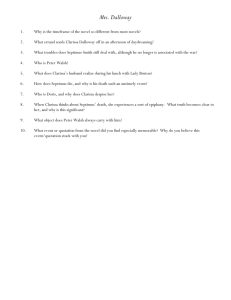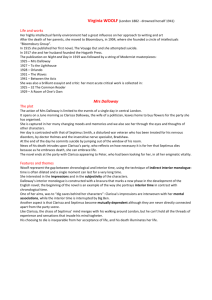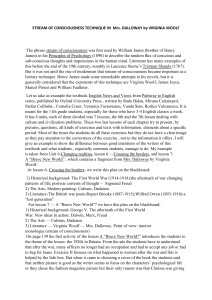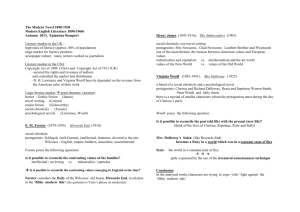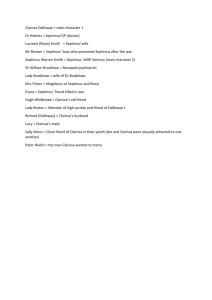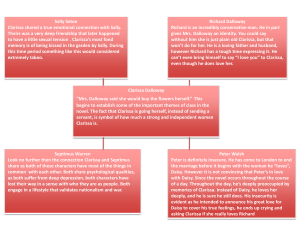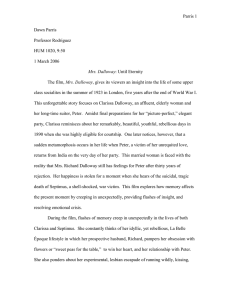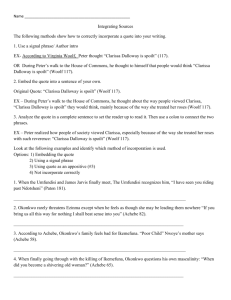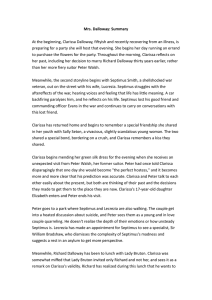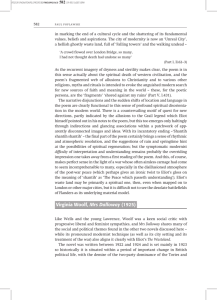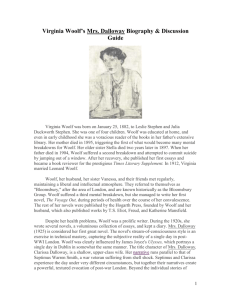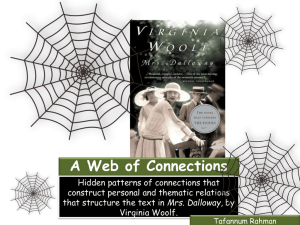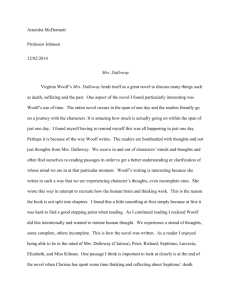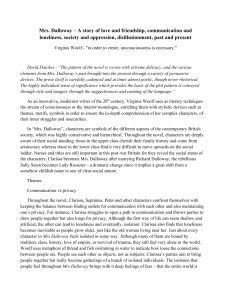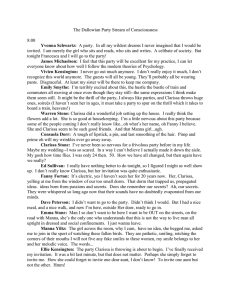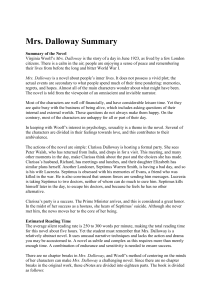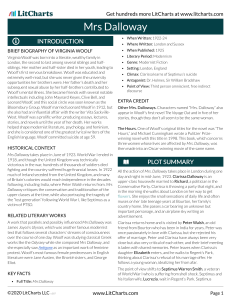Larking and Plunging: Mrs. Dalloway
advertisement
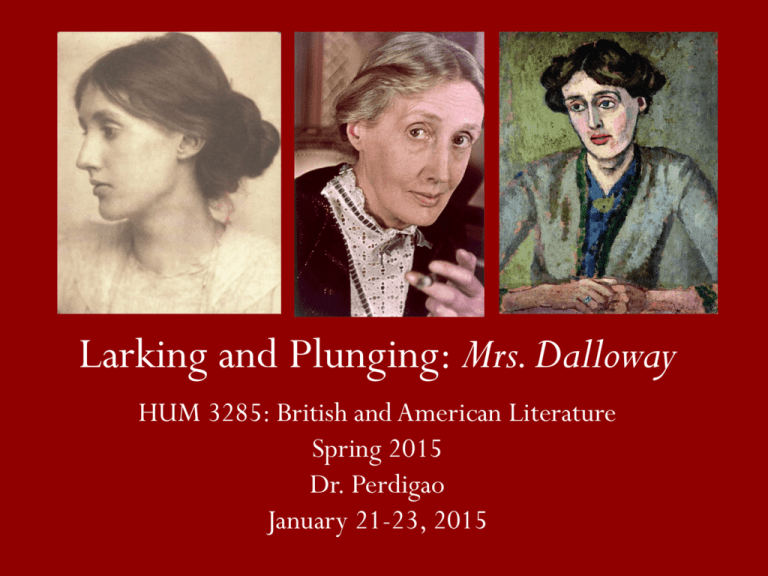
Larking and Plunging: Mrs. Dalloway HUM 3285: British and American Literature Spring 2015 Dr. Perdigao January 21-23, 2015 Robert Harms’ Mrs. Dalloway (1995) http://www.durhampress.com/harms/index.html Virginia Woolf (1882-1941) • Born Adeline Virginia Stephens on January 25, 1882 in London • Father Leslie Stephen, “Victorian critic, philosopher, biographer, and scholar” (Greenblatt 2080), member of “intellectual aristocracy” of Victorian England; mother Julia Jackson Duckworth, of Duckworth publishing family • Mother died in 1895; Virginia suffered mental breakdown; half sister Stella ran household until her death in 1897 • Father died in 1904; Virginia suffered second mental breakdown; brother dies of typhoid in 1906 • Vanessa ran household, moved family to Bloomsbury; “The Bloomsbury Group” • Leonard Woolf had joined Civil Service, returned in 1911; married Virginia Virginia Woolf (1882-1941) • Virginia started writing The Voyage Out in 1908, finished in 1913, published in 1915 • Second realistic novel Night and Day (1919) • 1917—Woolfs start own press, Hogarth; Virginia published through it after 1921; press published T. S. Eliot’s Poems (1919) • Moved back to London from Surrey, published Mrs. Dalloway (1925) • Orlando (1928), masculinity, femininity • • • • • • Jacob’s Room (1922) Mrs. Dalloway (1925) To the Lighthouse (1927) The Waves (1931) Three Guineas (1938) Between the Acts (1941) [posthumous] A shopping list • http://mrsdallowaymappingproject.weebly.com/ • Technology—planes, trains, and automobiles? • Sky-writing; ideas of language • Race, class, gender, sexual orientation • Repression and burial; return of consciousness • The doppelganger -double • Stevenson’s The Strange Case of Dr. Jekyll and Mr. Hyde (1886), Dostoevsky’s “The Double” (1846) A shopping list • Presence of war, for Dalloway and for Smith • As “war novel” • Unfulfilled characters, concealed relationships • Peter, Evans, Sally • Changing perspectives: “eye” versus “I” On Character • “on or about December, 1910, human character changed” (Puchner 1958) • • Woolf’s “Mr. Bennett and Mrs. Brown” (1924) http://www.columbia.edu/~em36/MrBennettAndMrsBrown.pdf • “I believe that all novels begin with an old lady in the corner opposite. I believe that all novels, that is to say, deal with character, and that it is to express character—not to preach doctrines, sing songs, or celebrate the glories of the British Empire, that the form of the novel, so clumsy, verbose, and undramatic, so rich, elastic, and alive, has been evolved.” (2-3) • • • • • • A Room of One’s Own (1929) Oxbridge: British Museum Access Shakespeare’s sister, Judith Sandra Gilbert’s and Susan Gubar’s “Madwoman in the Attic” (1979) A “room of her own” and five hundred a year Constructing England • Peter’s idea of war (50-52) • Idea of “civilization” post World War I • British citizens abroad, reimagining nation • Expatriates in London • Old England re-membered • Septimus’ story, entry into war, idea of the war (84-87) • Poet • Disillusionment • Rupert Brooke, Wilfred Owens even? • Psychoanalysis Repression and Release • Eros and Thanatos • Erotic longing, sexuality; desire for the end, violence, aggression • Creation and destruction • Latent death wish vs. Septimus’ statement that he will kill himself • Flames as symbol for both Clarissa and Septimus • Drowning as release, suffocation • Clarissa’s dress • Repression—memories, trauma, fears • Return of the buried self, consciousness Reflections and refractions • Five years after the war, 1923 • Day in June—Like James Joyce’s Ulysses; Woolf’s reception of Joyce’s text • Constructing character of Clarissa, shifting perspectives, “not this” and “not that” • Third person omniscient narrator; free indirect discourse with limited omniscience (learned from Joyce) • Dichotomies within the text • Movement between attraction to solitude and connection to others • Angst and delight • Death as solitude or embrace? • Uses of memory—for Clarissa, for Septimus Playing parts • No body, in memory with Peter—her dress, “something floating”: Nobody? • Must be completed by others because she is not real, a symbol • Idea of voyeurism—Clarissa in London; characters viewing Clarissa; Ellie at party • Insights come from watching others • Clarissa enacts his death • Actress all along Writing as revision • “The Hours” as working title • Differences in manuscript, with ending: Clarissa’s suicide as double plot; madness/sanity split • Party to end with her death: • “Eight said Big Ben, nine, ten, eleven; and then with a sort of finality, though presumably the strokes were accurately spaced the last no more empathic than the first twelve . . . But Clarissa was gone” • Changes to “For there she was” as symbolic death • http://litimag.oxfordjournals.org/content/early/2010/06/25/litimag.imq018.full Deconstruction • Versions of Clarissa at end; disembodied in last 8 pages, only alive in dialogue, part of conversations but absent (mentioned 32 times after her body disappears) • “Where’s Clarissa?”: “There she was” • Does she return? • Has the experience changed her view? • Postmodernist absent presence
